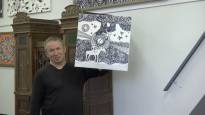SYKTYVKAR/GRADDOR Artist Yuri Lisovski presents his painting in his studio, where a man is dressed as a bear to hunt a bear.
Nature is helpless in the face of human cunning. However, one should not become greedy.
– If a person is in a harmonious state, he does not harm his environment, does not saw the branch he is sitting on, Lisovski says in Syktyvkar, the capital of the Republic of Komi.
– What we reflect on nature, nature gives us back. If we project chaos there, it will give us chaos, says Lisovski.
In many of his works, the worlds of men and women, humans and animals appear as intertwining loops. The language and themes show the influence of the Finno-Ugric folklore of the region.
Lisovski is counted as part of the school of ethnofuturism that emerged in the 1990s, which draws elements from folk tradition and combines them with new artistic form experiments.
The concept originates from Estonian cultural circles, and after the dissolution of the Soviet Union, it reached an echo base among Russia’s Finno-Ugric minority peoples in the republics of Mari, Udmurtia, Komi, Mordva and Karelia.
Juri Lisovski says that he does not take mythology as a fairy tale, but as a guide to life, because the models of the right kind of life are hidden in mythologies.
– I analyzed ancient mythology and came to the conclusion that basically nothing in the world has changed from the point of view of morality and harmonious behavior: how a person should live with other people, with nature, with higher and lower beings. I mean the material and spiritual world, Lisovski says.
– It inspired me. I even try to live by these laws to some extent. Harmony. I’m not saying I’m some kind of shaman. I’m an artist trying to get to the bottom of all this.
In Lisovski’s opinion, the ancient decorations and ritual images were made in such a special way that a modern artist is unable to reproduce them.
– They had some knowledge that we don’t have, Lisovski says.
In his works, Lisovski does not try to slavishly imitate the works of ancient artists, but to create new, own works.
– If we only focus on the past, we cannot imagine the future. What is the future like? Are we waiting for harmony and prosperity or mountains of waste and anger, greed?
A harmonious circle of life was found in Komi
Born in Šepetivka, Ukraine, Lisovski has settled into the northern lifestyle.
Lisovski arrived in Komi in 1979 and studied there to become a helmsman for river ships. After military service, he got married and decided to become an artist. His wife is from Komi.
In Komi, Lisovski found himself the center of the world, from which he does not want to leave.
– I noticed that people who are somehow rude, greedy, don’t take root here. The country will shake them off, says Lisovski.
– There is harmony in nature and in people’s relationships with each other. In the 80s, there were no locks on the doors here, Lisovski recalls. When leaving the house, people just put a stick next to the door as a sign.
– There were no thefts. Many say there was nothing to steal. Now there are locks.
Lisovski has a traditional Komi house in the village of Graddor near Syktyvkar. There, people still don’t lock the doors, but place a stick next to the house.
– People trust each other, Lisovski says.
Urbanization threatens the Komi language
An ethnologist lives in Graddor, a neighbor of Lisovski Pavel Limerov. He is a leading researcher at the Komi Institute of Language, Literature and Culture. He is also the editor-in-chief of Art magazine. Lisovski makes illustrations for the magazine.
– Traditionally, the Komi language has been the language of the countryside, of the villages. Since the beginning of the 90s, the youth of the villages have moved to the cities, and in the cities the population speaks Russian, says Limerov. That is why the Komi language is losing its status.
Still, there are still districts and villages where the Komi language has retained its importance.
– For example, in the village of Pomozdino in the district of Ust-Kulomsk, there is an enclave of good Komi language, there the youth have stayed in the villages and there they both speak Komi and make songs, even rock music in the Komi language.
Literature in the Komi language has a solid tradition starting from the 19th century, when it was promoted by the poet Ivan Kurchatov. Prose and lyrics are still written in comics.
– Another issue is that of course there are fewer and fewer readers, Limerov regrets.
Towards an ocean of harmony
The harmony that Juri Lisovski deals with in his art feels very far away in modern times, when Russia is at war in Ukraine, the confrontation with Western countries is intensifying and the borders are closing.
Lisovski still believes that people fundamentally want to live in harmony with each other and nature. An artist must look further than just to the present and the past.
– I support the fact that we are all human, regardless of whether we are Finno-Ugric, Slavic or Anglo-Saxon or whoever… because we are representatives of humanity. Lisovski ponders.
– Our mission is global – to live in harmony on Earth.
Lisovski refers to the Komi philosopher Kallistrat Žakovin a metaphor for humanity’s purpose: small streams flow into small rivers, small rivers into large rivers. And eventually the rivers reach the ocean.
– I think that the aspiration of all humanity is to reach an ocean of common harmony, where every small river feels like a part of the ocean.
